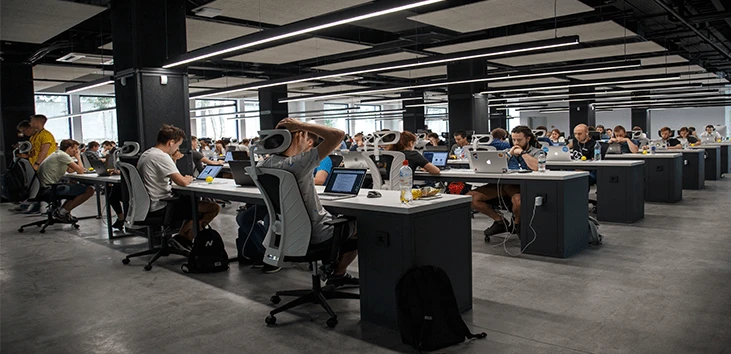Open plan offices have been around for over a century, and on the face of it you would think that they foster communication.
Far from it.
A recent Harvard study found that face-to-face interaction actually decreased when the walls came down, while the number of emails and text messages increased sharply.
In other words, people stop talking when they work open plan. That’s not great for collaboration.
The open plan office first came to prominence as a working style in 1906 when the architect Frank Lloyd Wright designed the Larkin Administration Building in New York.
Open plan has always had its critics. As Alexi Marmot, professor of facility and environment management at The Bartlett School of Graduate Studies at University College London says:
“The known [downsides] of open plan – noise, alienation, inability to adjust light and temperature, feeling like a small cog in a large machine – need to be overcome.
“This can be achieved through attention to design, who sits where, social events so people get to know one another, and especially by providing places for retreat for confidential discussions and concentrated work.”
In the world of tech open plan has several cheerleaders, not least the late Steve Jobs and Jack Dorsey of twitter, choosing to ignore employees’ concerns about privacy and distraction.
These tech giants argue that open plan forces workers to interact and collaborate more thus sparking waves of creativity.
A survey of over 42,000 US office workers found no evidence to bear this idea of unbridled creativity out.
As the British Psychological Society noted “there was a trend in the current study for workers in private offices to be more satisfied with ease of interaction than open-plan workers.”
A more cynical argument for the popularity of open plan with the people who pay for office space is that it’s is cheaper in real estate terms. That too is debatable without measurement to back it up.
Walls, and collaboration, come tumbling down
The Harvard study mentioned earlier went further than anecdotal data.
They studied two Fortune 500 companies who were planning to move to open plan offices and compared how their employees interacted before and after the new office design.
The subjects were fitted with “sociometric badges” which measured their movements, location, posture and even their conversations with their colleagues as well as reviewing the frequency of their email and text messages.
The findings of the survey are significant – a decrease of 70% of face-to-face time with email use increasing by up to 50%. To put this into context, from an average of 5.8 hours a day face to face collaboration this dropped to 1.7 hours a day over a 15-day period – a rapid drop.
Far from fostering collaboration the open plan office seems to cause people to become dramatically socially withdrawn.
But we’re sure there’s a better way to make open plan work as it is intended for both office worker and office owner. While there is definitely a time and a place for focused private work, such a significant drop in collaboration is unlikely to lead to a cross-pollination of ideas. Even Steve Jobs needed the talents of Steve Wozniak and Jonny Ive to create transformative technology such as the Apple II and iPod a reality – it required execution as well as vision.
There are alternatives. As the infographic below shows there are other ways of working. Office design is evolving towards working styles that can foster “deep work” as well as having the flexibility to enable collaboration when required.
The appliance of science
Today’s offices have managed to break down the barriers through the use of technology.
Desk booking software, such as Rendezvous, has made it much easier for companies to adopt agile and flexible working styles as staff can easily book a hot desk from their mobile device.
The rise of sensor technology has made it effortless for organisations to make collaborative and deep working a reality.
Teams can easily choose a productive space to work together, or alone, using a graphical floor plan and then simply check in automatically to the space as the sensor detects their presence.
Time spent looking for a seat can be better spent on knowledge work. This technology is ideal for checking into less conventional seating configurations such as huddle spaces.
Staff who can’t access a graphical floor plan or a mobile booking solution can spend between 15 to 30 minutes a day locating a suitable space.
For an organisation with, say, 100 flexible workers that could translate to between 25 and 50 hours being wasted every single day.
The benefits of sensor technology extend far greater than a seamless booking process. The solution is constantly monitoring and tracking space utilisation in real time.
Where previously real estate managers had to rely on inaccurate, time-consuming and biased manual surveys they now have a wealth of rock solid data at their fingertips.
This data takes all the guesswork out of how your space is being used. The data, with some imagination, is highly actionable.
Savvy real estate managers are taking this data to:
- > Assign desks – based on patterns of demand they can build in business rules as to how best desks should be allocated and whether their staff need to book in advance or whether they can be more flexible
- > Make savings – if occupancy is lower than expected then it may be a good idea to, for example, close a whole floor that isn’t being used
- > Pinpoint working patterns – if the ratio of people to desks is too high while the number of face to face meetings is low then it may be an idea to reconfigure your meeting room into hot desk stations.
Conclusion
Open plan is clearly not the panacea for creative working that its advocates feel it is. However, the need for collaborative working is still there. Technology is the dominant driver of this.
Clearly, office life has moved on from the 1900s where the most sophisticated piece of office equipment was probably a typewriter.
The average worker is now carrying more computing power in their pockets than NASA had at their disposal for the Moon landing in 1969. With this power they no longer need to be shackled to a desk as work becomes more of an activity and less of a destination.
It’s time for a workspace that’s more in tune with this shift in workers’ needs, with technology that provides a frictionless user experience while saving time and money.
See how the NHS put technology in place to support their agile working strategy in this short video:


